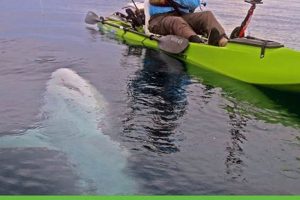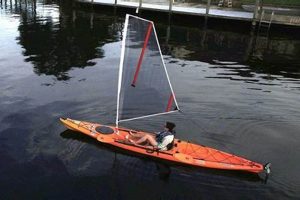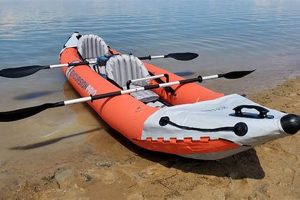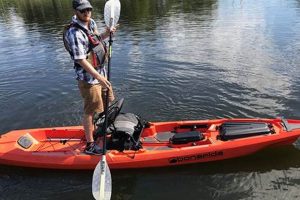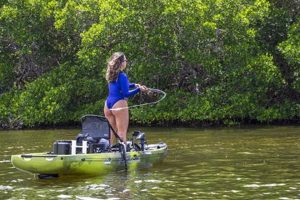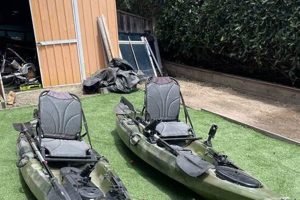Adapting kayaks for angling involves adding, adjusting, or removing equipment to optimize the vessel for stability, fish-finding capabilities, and gear management. A common example involves installing rod holders and mounting a fish finder to a recreational kayak. This transformation creates a dedicated fishing platform.
A properly outfitted fishing kayak offers substantial advantages, including improved angler safety, enhanced fishing efficiency, and greater access to diverse fishing locations. Historically, anglers adapted existing watercraft for fishing. The evolution of specialized kayak designs and accessories reflects the growing popularity of this fishing method, emphasizing customization for comfort and effectiveness.
This discussion will cover key adaptations, focusing on categories such as stability enhancements, fish-finding technology integration, storage solutions, and propulsion systems. It will also address factors like kayak type, fishing style, and budget considerations.
Tips for Kayak Fishing Modifications
Careful planning and execution are crucial for successful kayak modifications. These tips offer guidance for enhancing a fishing kayak’s functionality and safety.
Tip 1: Prioritize Stability: Stability is paramount, especially when adding accessories and equipment. Consider outriggers or wider hulls for increased stability, especially for stand-up fishing.
Tip 2: Strategic Rod Holder Placement: Rod holder placement should allow easy access and prevent entanglement. Anglers should consider their casting style and target species when choosing locations.
Tip 3: Invest in a Quality Fish Finder: A fish finder provides crucial underwater insights. Transducers should be mounted correctly to avoid interference and ensure accurate readings.
Tip 4: Optimize Storage Solutions: Secure storage for tackle, gear, and personal items is essential. Dry bags, crates, and specialized compartments protect equipment from water damage and maintain organization.
Tip 5: Consider Propulsion Options: Paddle power offers quiet, maneuverable operation, while pedal or motor drives provide speed and hands-free fishing opportunities. Each propulsion method presents advantages and disadvantages depending on fishing style and location.
Tip 6: Safety First: Always prioritize safety. Wear a personal flotation device, carry essential safety gear, and inform someone of fishing plans. Properly installed modifications enhance safety, preventing equipment failure and potential accidents.
Tip 7: Research and Plan: Before making any modifications, research compatible equipment, watch instructional videos, and consult experienced kayak anglers. Careful planning ensures a functional and efficient fishing platform.
By following these guidelines, anglers can create a customized kayak fishing setup that optimizes performance, enhances safety, and maximizes enjoyment on the water.
These modifications contribute significantly to a successful and enjoyable fishing experience. The following section concludes with essential considerations for kayak fishing adventures.
1. Stability
Stability is a critical factor in kayak fishing, directly impacting safety and effectiveness. Modifications impacting stability influence an angler’s ability to cast, land fish, and navigate various water conditions. A stable platform minimizes the risk of capsizing, especially during challenging maneuvers like fighting a strong fish or navigating rough waters. For instance, adding outriggers significantly enhances stability, allowing anglers to stand and fish with greater confidence.
Several modifications contribute to kayak stability. Wider hulls inherently provide more stability than narrower designs. Outriggers, essentially pontoons attached to the kayak’s sides, dramatically increase stability, particularly valuable for stand-up fishing. Weight distribution also plays a crucial role; proper placement of gear and equipment maintains balance and prevents tipping. Adding weight low in the kayak enhances stability, while top-heavy configurations increase instability. Understanding these principles allows anglers to customize their kayaks for optimal stability based on their fishing style and environment.
Enhanced stability directly translates to increased fishing effectiveness and safety. A stable kayak allows anglers to focus on fishing rather than constantly correcting balance. This improved stability is crucial for techniques requiring precision casting, like fly fishing, or powerful hooksets. Furthermore, a stable platform is essential for safe re-entry after an accidental capsize. Ultimately, prioritizing stability through thoughtful modifications ensures a safer and more productive kayak fishing experience.
2. Storage
Storage solutions are integral to kayak fishing modifications, directly impacting organization, efficiency, and safety. Limited space necessitates efficient storage systems to accommodate tackle, gear, safety equipment, and personal items. Inadequate storage can lead to clutter, hindering access to essential equipment and potentially creating safety hazards. Conversely, well-designed storage solutions maximize available space, allowing anglers to carry necessary gear while maintaining a clean and organized cockpit. For example, incorporating waterproof storage compartments safeguards electronic devices and important documents from water damage, while designated tackle boxes keep lures and hooks readily accessible. Similarly, strategically placed bungee cords or cargo nets secure larger items like coolers and spare paddles.
Practical applications of optimized storage extend beyond mere convenience. Efficient storage systems streamline fishing processes, allowing anglers to quickly switch lures, change rigs, or access tools without disrupting their fishing flow. This enhanced efficiency translates to more time spent fishing and less time searching for misplaced gear. Moreover, proper storage contributes to safety by preventing loose items from shifting during navigation or interfering with paddling strokes. Securely stowed gear minimizes the risk of entanglement and ensures a clear cockpit, crucial for quick reactions in unexpected situations.
In summary, effective storage solutions are essential components of kayak fishing modifications. They optimize space utilization, enhance fishing efficiency, and contribute to overall safety. From waterproof compartments for electronics to specialized tackle storage, these modifications significantly improve the kayak fishing experience. Addressing storage needs through careful planning and appropriate modifications allows anglers to focus on fishing, maximizing both enjoyment and success on the water.
3. Rod Holders
Rod holders constitute a fundamental element in kayak fishing modifications, bridging the gap between a standard kayak and a dedicated fishing platform. They provide secure storage for fishing rods, freeing an angler’s hands for paddling, maneuvering, and landing fish. This seemingly simple modification has profound implications for both fishing efficiency and safety. Without rod holders, anglers must constantly manage their rods, increasing the risk of dropping valuable equipment or creating entanglement hazards. For example, navigating through tight spaces or encountering unexpected obstacles becomes significantly more challenging while simultaneously holding a fishing rod. Dedicated rod holders mitigate these risks, allowing for smoother navigation and quicker responses to changing conditions.
Furthermore, rod holder placement significantly impacts fishing techniques and success. Flush-mounted rod holders positioned along the gunwales facilitate trolling, keeping lines in the water while paddling. Adjustable rod holders offer versatility for different fishing styles, allowing anglers to position rods at optimal angles for casting or drifting. Specialized rod holders, such as those designed for fly fishing, cater to specific techniques and equipment. Strategic placement maximizes fishing efficiency by keeping rods readily accessible and positioned for optimal presentation of lures or bait. This efficient setup allows anglers to cover more water and react quickly to bites, increasing the likelihood of a successful catch.
In conclusion, rod holders are not merely convenient accessories but essential components of kayak fishing modifications. They contribute significantly to safety by securing rods and preventing entanglement. Strategic placement of rod holders optimizes fishing techniques, enabling efficient lure presentation and increased responsiveness. Integrating rod holders into kayak modifications transforms the vessel into a dedicated fishing platform, enhancing both the safety and effectiveness of the angling experience.
4. Fish Finders
Fish finders represent a significant advancement in kayak fishing modifications, providing anglers with real-time underwater insights previously unavailable. Integrating these electronic devices transforms the kayak into a sophisticated fishing platform, significantly enhancing fish-finding capabilities. This technology allows anglers to locate fish, identify underwater structures, and understand bottom composition, crucial factors for successful angling.
- Locating Fish:
Fish finders utilize sonar technology to transmit sound waves into the water. These waves bounce off objects, including fish, and return to the transducer. The fish finder interprets these returning signals, displaying the location and size of fish on a screen. This real-time information enables anglers to target specific areas holding fish, increasing fishing efficiency.
- Identifying Underwater Structures:
Beyond locating fish, fish finders reveal underwater structures like submerged vegetation, rocks, and drop-offs. These structures often serve as fish habitats or feeding grounds. Understanding the underwater landscape allows anglers to strategically position their kayaks and target areas with higher probabilities of holding fish. For example, identifying a submerged point extending from a shoreline can reveal a prime ambush location for predatory fish.
- Understanding Bottom Composition:
Fish finders also provide insights into bottom composition, differentiating between mud, sand, gravel, and rock. This information is valuable for determining appropriate fishing techniques and lure selection. Certain fish species prefer specific bottom types; understanding this relationship increases the chances of a successful catch. For instance, knowing whether the bottom is sandy or rocky informs lure choices, as some lures are more effective in certain environments.
- GPS Integration:
Many modern fish finders integrate GPS technology, allowing anglers to mark waypoints, track their routes, and navigate back to productive fishing spots. This feature is invaluable for returning to successful locations, especially in large bodies of water or unfamiliar areas. GPS integration also contributes to safety by providing navigational assistance and facilitating return to launch points.
Incorporating a fish finder into kayak modifications elevates the fishing experience from simple casting and retrieving to a strategic pursuit informed by real-time data. These devices offer valuable insights into fish location, underwater structures, and bottom composition, empowering anglers to make informed decisions and optimize fishing techniques. The combination of sonar technology, GPS integration, and user-friendly displays makes fish finders an indispensable tool for the modern kayak angler.
5. Propulsion
Propulsion systems represent a critical aspect of kayak modifications for fishing, directly impacting an angler’s ability to cover water efficiently, conserve energy, and position the vessel effectively. Choosing the right propulsion system depends on individual fishing styles, target species, and the environment. Each method, from traditional paddles to advanced pedal or motor drives, offers distinct advantages and disadvantages.
- Paddle Propulsion:
Traditional paddles offer a quiet, maneuverable, and cost-effective means of propulsion. They provide excellent control in shallow water, tight spaces, and areas with submerged obstacles. Paddle propulsion relies on angler effort, requiring physical exertion and potentially limiting fishing time due to fatigue. However, the quiet operation of paddles can be advantageous in stealth approaches to fish-holding areas.
- Pedal Propulsion:
Pedal-powered kayaks utilize leg muscles, freeing hands for fishing. These systems provide efficient and relatively quiet propulsion, enabling longer fishing sessions with reduced fatigue. Pedal drives excel in open water and moderate currents, allowing anglers to cover greater distances and maintain position with less effort. However, pedal-driven systems can be more expensive than paddle kayaks and may have limitations in very shallow water or areas with dense vegetation.
- Motorized Propulsion:
Electric motors offer the greatest speed and range, ideal for covering large bodies of water or battling strong currents. Motorized kayaks require less physical exertion than paddle or pedal drives, maximizing fishing time and reducing fatigue. However, motors add weight and complexity, increasing the cost and maintenance requirements of the kayak. Furthermore, electric motors require charging and may introduce noise that can spook fish.
- Hybrid Propulsion:
Some anglers opt for a hybrid approach, combining paddle power with either a pedal or motor drive. This versatile approach allows anglers to leverage the advantages of each system based on changing conditions or fishing needs. For example, an angler might use a motor to reach a distant fishing spot, then switch to paddle power for quiet maneuvering in shallow water. Hybrid propulsion enhances versatility but typically adds complexity and cost.
Selecting an appropriate propulsion system depends on individual fishing preferences and target environments. Paddle propulsion suits anglers seeking a quiet, maneuverable, and cost-effective option. Pedal drives provide efficient hands-free propulsion, ideal for longer trips in open water. Motorized kayaks excel in covering vast distances or challenging currents, while hybrid systems offer versatile solutions adaptable to varying conditions. Carefully considering propulsion options optimizes kayak performance for specific fishing needs, enhancing both efficiency and enjoyment on the water.
Frequently Asked Questions
Addressing common inquiries regarding kayak modifications for fishing provides clarity and guidance for anglers seeking to optimize their equipment.
Question 1: Does modifying a kayak void its warranty?
Modifications can potentially void manufacturer warranties, particularly structural alterations. Consulting the manufacturer’s warranty policy before undertaking modifications is recommended. Some manufacturers offer specific guidelines or approved modifications that maintain warranty coverage.
Question 2: What are the most important safety modifications for a fishing kayak?
Prioritizing stability enhancements like outriggers or wider hulls is crucial for safety. Additional safety modifications include installing a bilge pump, carrying essential safety gear (whistle, flares, first-aid kit), and wearing a personal flotation device. Proper lighting for low-light conditions further enhances safety.
Question 3: Are there specific modifications for different types of fishing?
Specific fishing styles benefit from tailored modifications. Trolling requires rod holders positioned for multiple lines. Fly fishing necessitates specialized rod holders and storage for fly-fishing gear. Kayak anglers targeting larger species benefit from reinforced rod holders and advanced anchoring systems.
Question 4: How does one choose the right fish finder for a kayak?
Fish finder selection depends on factors like budget, target species, and water conditions. Screen size, transducer type, and GPS capabilities are key considerations. Consulting experienced kayak anglers or electronics retailers provides valuable insights for selecting appropriate fish finder models.
Question 5: What are the legal requirements for modified fishing kayaks?
Legal requirements for modified kayaks vary by jurisdiction. Regulations regarding lighting, registration, and required safety equipment apply to modified kayaks. Consulting local boating authorities ensures compliance with specific regulations, particularly regarding motorized kayaks.
Question 6: How does one maintain modifications on a fishing kayak?
Regular maintenance preserves the functionality and longevity of kayak modifications. Periodic inspection, cleaning, and lubrication of moving parts are essential. Protecting electrical components from water damage and ensuring secure attachment of accessories prevent malfunctions and ensure long-term performance.
Understanding these key aspects of kayak modifications empowers informed decisions, enhancing safety, efficiency, and enjoyment on the water.
The following section provides further resources and concludes this comprehensive guide to kayak modifications for fishing.
Kayak Modifications for Fishing
Adapting kayaks for fishing enhances both safety and effectiveness on the water. Strategic modifications, ranging from stability enhancements and optimized storage to advanced electronics and propulsion systems, transform standard kayaks into dedicated fishing platforms. Considerations of fishing style, target species, and local regulations inform appropriate modifications. Proper installation and regular maintenance ensure long-term performance and angler safety.
Thoughtful planning and execution of kayak modifications unlock the full potential of kayak fishing. This approach empowers anglers to explore diverse waterways, target specific species effectively, and maximize their time on the water. Continuous exploration of innovative modifications promises further advancements in kayak fishing technology, enhancing angling experiences for years to come.

